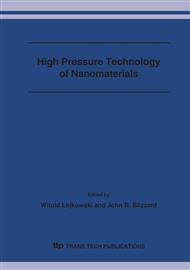[1]
J.A. Disegi, L. Eschbach, Stainless steel in bone surgery, Injury 31(S4) (2000), pp.4-6.
DOI: 10.1016/s0020-1383(00)80015-7
Google Scholar
[2]
C. Schmidt, A. Ignatius, L.E. Claes, Proliferation and differentiation parameters of human osteoblasts on titanium and steel surfaces, Journal of Biomedical Materials Research 54 (2001), pp.209-15.
DOI: 10.1002/1097-4636(200102)54:2<209::aid-jbm7>3.0.co;2-7
Google Scholar
[3]
K. Brodji, J. Y. Jouzeau, D. Mainard, E. Payan, P. Netter, K. T. Rie, T. Stucky, M. Hage-Ali, Cytocompatibility of Ti-6Al-4V and Ti-5Al-2. 5Fe alloys according to three surface treatments, using human fibroblasts and osteoblasts, Biomaterials 17 (1996).
DOI: 10.1016/0142-9612(96)83289-3
Google Scholar
[4]
K. J. Kurzydlowski, Hydrostatic extrusion as a method of grain refinement in metallic materials, Materials Science Forum Vol. 503-504 (2006), pp.341-348.
DOI: 10.4028/www.scientific.net/msf.503-504.341
Google Scholar
[5]
Information on http: /www. fzs. tu-berlin. de/html/en/strpr_hydro_ani. html.
Google Scholar
[6]
R. Z. Valiev, R. K. Islamgaliev, I. V. Alexandrov, Bulk nanostructured materials from severe plastic deformation, Progress in Materials Science 45 (2000), pp.103-189.
DOI: 10.1016/s0079-6425(99)00007-9
Google Scholar
[7]
T. Sourmail, Precipitates in creep resistant austenitic stainless steels, information on http: /www. thomas-sourmail. org/papers_html/precipitation_review.
Google Scholar
[8]
T. Suter, H. Böhni, Microelectrodes for corrosion studies in Microsystems, Electrochimica Acta 47 (2001) pp.191-199.
DOI: 10.1016/s0013-4686(01)00551-5
Google Scholar
[9]
E. Wallen, O. Sundqvist, Cleanliness of vacuum-arc remelted 316LVM, Paper presented at Semicon Southwest, Austin Texas USA, October 14-15 (1997).
Google Scholar
[10]
Garbacz H, Lewandowska M, Klassek D, Pachla W, Kurzydlowski KJ, Nanometals for medical applications, submitted for publication in the proceedings of EMRS Fall Meeting (2004).
Google Scholar
[11]
S. Murugan, S. K. Rai, P. V. Kumar, T. Jayakumar, B. Raj, M. S. C. Bose, Temperature distribution and residual stresses due to multipass welding in type 304 stainless steel and low carbon steel weld pass, International Journal of Pressure Vessels and Piping 78 (2001).
DOI: 10.1016/s0308-0161(01)00047-3
Google Scholar
[12]
H. Böhni, T. Suter, F. Assi, Micro-electrochemical techniques for studies of localized processes on metal surfaces in the nanometer range, Surface and Coatings Technology 130 (2000) pp.80-86.
DOI: 10.1016/s0257-8972(00)00681-2
Google Scholar
[13]
I. C. Noyan, J. B. Cohen, Residual stress measurements by diffraction and interpreatation, Springer-Verlag, New York Inc. (1987).
Google Scholar


